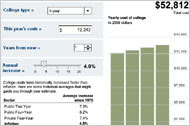The Graduation Gap in Texas Universities
Picture of Texas State University Business School by Lauren Kahn
For years, Texas universities have focused on getting more students, particularly low-income students, onto their campuses. The hard part, it turns out, is getting them to leave — with degrees.Of the 32 Texas state universities tracked by the U.S. Department of Education's National Center for Education Statistics, only five schools have self-reported graduation rates above 50 percent.
The University of Texas at Austin and Texas A&M University have the highest graduation rates: Both graduate 78 percent of their students in six or fewer years, but that's still a step behind national peers like the University of California, Los Angeles, and the University of Michigan, which graduate 90 percent and 88 percent, respectively.
At the bottom of the Texas list is Texas Southern University, which graduates just 12 percent of students in six years, followed by the University of Houston-Downtown and the University of Texas at Brownsville, each at 16 percent.
The Higher Education Coordinating Board tried to tackle the issue in late April, approving new formula-financing recommendations from Higher Education Commissioner Raymund Paredes. Included is a seemingly small change that he hopes will go a long way to improving success rates: Paredes wants to change the “census date,” on which funding is based, from the 12th day of classes to the final day of the semester — ensuring, he says, that schools get paid only for successful students. But others, including state Rep. Scott Hochberg, D-Houston, the vice chairman of the House Public Education Committee, believe that change would succeed only in starving colleges targeting low-income students of much-needed revenue, creating a perverse incentive for schools to avoid admitting harder-to-educate students.
University of Houston - Downtown
pictured above.
Paredes and Hochberg and other policymakers agree that graduation rates must improve to justify investments in higher education, of which students themselves are bearing an ever-increasing share amid tightening state budgets. “If you look at Texas Higher Education over the past 20 years, it’s very clear that the emphasis has been providing more and more access, particularly to low-income students,” Paredes says. “We have made tremendous gains in access. We haven’t made commensurate gains in terms of students actually graduating.
“The point of his financing proposal, he says, “is to create incentives for institutions to place emphasis on more than simply enrollment. It’s not just who you enroll. It’s who you keep.”
Rewarding admissions, not achievement.
| Bottom 5: Six-Year Grad Rate | 2007 |
|---|---|
| Texas Southern University | 12% |
| University of Houston-Downtown | 16% |
| The University of Texas at Brownsville | 16% |
| Sul Ross State University | 19% |
| The University of Texas at El Paso | 29% |
“I disagree with it,” he says. “I didn’t do it in the last legislative session. I had the chance to push it forward. I did not.”
Colleges can easily predict graduation rates based on student demographic data, Hochberg says. So such a change merely rewards universities with tougher admissions standards — thereby excluding students more likely to drop out.
“If you just say, ‘We’re going to pay for completed courses,’ then what you’ve done is just given a big boost to A&M and UT-Austin,” he says. “You would expect UT-Brownsville to have a lower graduation rate than UT-Austin, but you wouldn’t expect it to be 10 points below similar institutions in other states.”
Hochberg hasn’t yet figured out an alternative to Paredes' proposal. “I’m trying to learn the answer to that right now,” he says. “I’m in the process of setting up meetings with university presidents. I’ve spent quite a bit of time reading what other institutions have done, what other states have done.” He says it’s “absolutely” his intent to have a game plan ready for next session.
| Top 5: Six-Year Grad Rate | 2007 |
|---|---|
| 78% | |
| The University of Texas at Austin | 78% |
| Texas Tech University | 56% |
| The University of Texas at Dallas | 56% |
| Texas State University | 55% |
In his recent financing recommendations, Paredes also proposed a “comprehensive shared responsibility model,” hoping all stakeholders in the success of college students — the state, institutions of higher education, the public education system, families — are collaboratively pulling their weight.
“We are working with K-12 to increase numbers that graduate from high school ready to do college-level work,” he said. “We also want the state to recognize what its responsibility is.”
Both Hochberg and state Sen. Judith Zaffirini, D-Laredo, chair of the Senate Higher Education Committee, advocate bolstering college advising, noting with dismay that students are too often encouraged to lighten their course loads. “They arrive with a mindset of receiving a four-year degree, and almost immediately they develop different mindset: that they have six years to get that same degree,” Zaffirini says.
Parents and students should realize that getting the degree in less time can save them money, she says, and the state can reinforce that message with initiatives like Texas’ B-On-Time program. Established by the Legislature in 2003, it’s essentially a no-interest loan that gets forgiven if a student graduates in four years with a “B” average. But the program has suffered from lack of state financing, she says.
In his formula financing recommendations for the next biennium, Paredes only suggests an increase to account for enrollment growth. “A lot of people in higher education would argue that the status quo is underfunded,” he acknowledges, “but we know it’s going to be a tough budget situation, so we’re just asking to maintain the status quo.”
But even the status quo will cost more than $700 million additional dollars — a number that Hochberg calls “a big bite.”
Zaffirini believes higher education financing should focus on the long-term economic benefits to the state rather than only on the stress on the current budget cycle. By increasing state investments, she says, “we are increasing the educated students’ earning capacity and their potential for generating tax revenue.” Her fellow legislators, she contends, do not all see it the same way.
Closing the gap
In 2000, Texas launched Closing the Gaps by 2015, a strategic plan to bring the state to national parity on graduation rates, and other measures of higher education success, in 15 years' time. A study by the Perryman Group, a economic research firm based in Waco, found that meeting those goals would result in increases of $489 billion in total spending, $194 billion in gross state product and $122 billion in personal income — as well as 1 million new jobs by 2030.
Though progress has been made, not all targets have been met thus far. The coordinating board recently approved an Accelerated Plan for Closing the Gaps by 2015, an update to the original that emphasizes the need to focus on the higher ed participation of Hispanic and African-American students, particularly males. Paredes stops short of saying he’s confident the state can meet those goals, though “it’s doable and I’m hopeful,” he says. “But we have to get certain things to fall into place.”
From Lone Star Ed Consulting ... What are your thoughts regarding the Graduation Gap in Texas Universities? What do you propose we do to ensure that other universities, besides the top 5 universities in Texas, remain prosperous and continue to graduate deserving candidates? Is the recession going to merely increase this issue and widen the graduation gap for low-income families?
College News from Texas will delve further into a related issue, the increasing Gender Gap in Post-Secondary Education. By 2019, it is estimated by the National Center for Education Statistics (NCES) that women will account for 59 percent of total undergraduate enrollment and 61 percent of total “postbaccalaureate” enrollment at colleges and universities throughout the country.
The information was provided by educational consultant, Lauren Kahn, CEO of Lone Star Ed Consulting. If you would like more information about Lone Star Ed Consulting's college planning services, please e-mail Lauren Kahn or call her at 512-294-6608. You can also view LSEDC's brochure here or purchase LSEDC's services on the blogsite on the right hand side.














No comments:
Post a Comment
Thank you for your comment. Your input is greatly appreciated. - College News from Texas - Lauren Kahn, M.A.